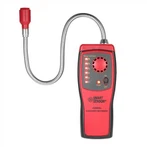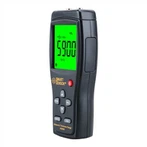Measuring Transistor with Pointer Multimeter
The test can be divided into test under power-on state or power-off state test. In the power-on state test can measure the base voltage. The general silicon tube is 0.7V. The germanium tube is 0.2-0.3V. Instructions work fine. Otherwise it is cut off. In the off state, you can test whether the forward and reverse resistance of the PN junction of the triode is normal. Some triodes cannot be detected normally due to the small resistance or inductance connected in parallel in the circuit, so they can be removed for measurement.
The pins of the triode must be correctly identified, otherwise, the connected circuit will not only fail to work normally, but may also burn out the transistor. Knowing the type and electrode of the transistor, the method of judging the quality of the transistor by the pointer multimeter is as follows:
①Measure the NPN transistor: put the ohm block of the multimeter at "R × 100" or "R × lk", connect the black test lead to the base, and connect the red test lead to the other two poles successively. The resistance values are all small, then connect the red test lead to the base, and connect the black test lead to the other two electrodes successively. If the resistance values measured twice are large, it means that the triode is good.
②Measure the PNP transistor: put the ohm block of the multimeter at "R × 100" or "R × lk", connect the red test lead to the base, and connect the black test lead to the other two poles successively. The resistance values are all small, then connect the black test lead to the base, and connect the red test lead to the other two electrodes successively. If the resistance values measured twice are large, it means that the triode is good.
When the marks on the triode are not clear, you can use a multimeter to preliminarily determine the quality and type of the triode (NPN or PNP), and identify the three electrodes e, b, and c. Use a pointer multimeter to measure the triode test method as follows:
①Use a pointer multimeter to determine the type of the base and the triode: set the ohm of the multimeter to "R × 100" or "R × lk", first assume that a certain pole of the triode is "base", and connect the black test lead to the hypothetical On the base, connect the red test lead to the other two poles successively. If the resistance values measured twice are very small (or about several hundred ohms to several thousand ohms), the hypothetical base is correct, and The tested triode is an NPN type tube; as above, if the resistance values measured twice are very large (about several thousand ohms to tens of thousand ohms), then the assumed base is correct, and the tested triode is a PNP type Tube. If the resistance values measured twice are one large and one small, then the originally assumed base is wrong. At this time, the other electrode must be assumed to be the "base" again, and then repeat the above test.
②Judging the collector and emitter e: still place the ohm block of the pointer multimeter at "R × 100" or "R × 1k", take the NPN tube as an example, connect the black test lead to the hypothetical collector c, and the red test lead Connect to the hypothetical emitter e, and pinch b and c poles with your hands (b and c cannot be directly contacted), pass through the human body, connect a bias resistor between b and c, and read the resistance value shown on the meter head , and then connect the two test leads reversely and retest. If the resistance value measured for the first time is smaller than the first time, it means that the null hypothesis is true, because the resistance values of c and e are small, which means that the current passing through the multimeter is large and the bias is normal. The current pointer multimeter has an interface for measuring the magnification of the triode (Hfe). You can estimate the magnification of the triode.






